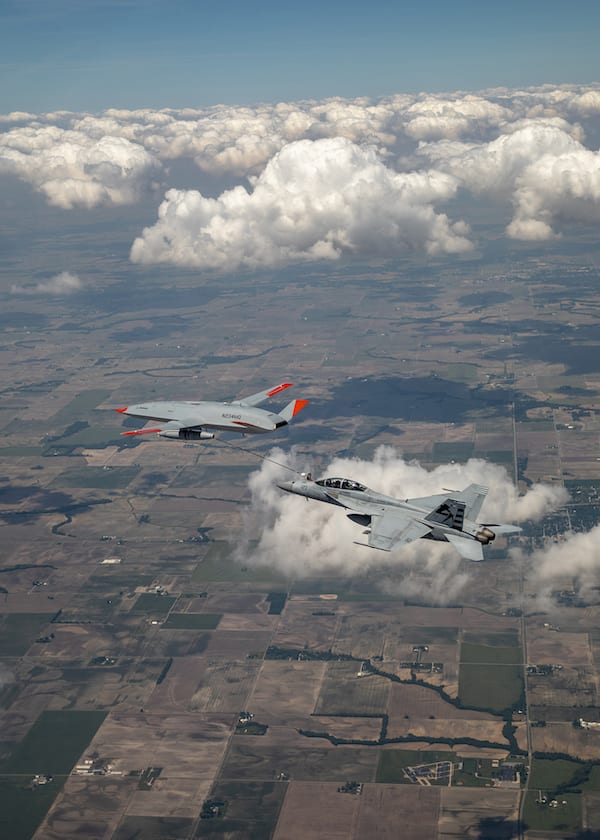
The Boeing MQ-25 T1 test asset transfers fuel to a U.S. Navy F/A-18 Super Hornet on June 4, marking the first time in history that an unmanned aircraft has refueled another aircraft. The MQ-25 Stingray will assume the carrier-based tanking role currently performed by F/A-18s, allowing for better use of the combat strike fighters and helping extend the range of the carrier air wing. (Photo: Kevin Flynn)
The Boeing MQ-25A test asset, called T-1, conducted the first ever unmanned tanker to manned aircraft aerial refueling operation last week, the Navy announced June 7.
This flight demonstration proved the MQ-25A Stingray carrier-based unmanned tanker can fulfill its stated role using the standard probe-and-drogue aerial refueling method, the Navy and Boeing said.
The flight test was based around the MidAmerica Airport in Mascoutah, Ill., where the T-1 is based for testing. During the flight test on June 4, a Navy F/A-18 E/F Super Hornet approached the unmanned T-1 in close formation behind it, conducted a formation evaluation, wake survey, drogue tracking and then plugged into the T-1. The T-1 successfully transferred fuel from its Aerial Refueling Store (ARS) to the Super Hornet.
Boeing said this maneuver required as little as 20 feet of separation between the aircraft and both were flying at “operationally relevant speeds and altitudes.”

The Boeing MQ-25 T1 test asset transfers fuel to a U.S. Navy F/A-18 Super Hornet on June 4, marking the first time in history that an unmanned aircraft has refueled another aircraft. The MQ-25 Stingray will assume the carrier-based tanking role currently performed by F/A-18s, allowing for better use of the combat strike fighters and helping extend the range of the carrier air wing. (Photo: Kevin Flynn)
The test involved several contacts from the T-1 ARS connecting to the Super Hornet with both dry or non-fuel connections, and wet or fuel transfer connections, at both 10,000 and 15,000 feet at various speeds.
During a press call on Monday, Boeing MQ-25 program director Dave Bujold said this test transferred 300 pounds of fuel in an initial refueling event followed by a second transfer of about 25 pounds of fuel. The test lasted for a total of about 4.5 hours with “well over” 10 minutes of ARS contact time.
Bujold also said this fuel amount was chosen because the ARS pod has a low fuel indication to prevent pump issues and they successfully tested the feature by using less fuel than the pod can hold.
The test included aircraft from Air Test and Evaluation Squadron 23 (VX-23) based at Naval Air Station Patuxent River, Md. to provide additional visual checks during the exercise.
“This flight lays the foundation for integration into the carrier environment, allowing for greater capability toward manned-unmanned teaming concepts. MQ-25 will greatly increase the range and endurance of the future carrier air wing – equipping our aircraft carriers with additional assets well into the future,” Rear Adm. Brian Corey, head of Program Executive Office for Unmanned Aviation and Strike Weapons, said in a statement.
“This is our mission, an unmanned aircraft that frees our strike fighters from the tanker role, and provides the Carrier Air Wing with greater range, flexibility and capability. Seeing the MQ-25 fulfilling its primary tasking today, fueling an F/A-18, is a significant and exciting moment for the Navy and shows concrete progress toward realizing MQ-25’s capabilities for the fleet,” Capt. Chad Reed, program manager for the Navy’s Unmanned Carrier Aviation program office (PMA-268), added.
Reed said the test will provide early data on airwake interactions as well as guidance and control. The MQ-25A team is next set to analyze the data to determine if any potential adjustments and early software updates are needed, but the Navy said this would not impact the program’s test schedule.
The Navy said further testing with T-1 will continue for the next “several months” and will include flight envelope expansion, engine testing and eventually lead to it being shipped to Norfolk, Va. for deck handling demonstrations onboard an aircraft carrier later this year.
President and CEO of Boeing’s Defense, Space and Security division Leanne Caret boasted the importance of the milestone.
“This history-making event is a credit to our joint Boeing and Navy team that is all-in on delivering MQ-25’s critical aerial refueling capability to the fleet as soon as possible. Their work is the driving force behind the safe and secure integration of unmanned systems in the immediate future of defense operations,” Caret said in a statement.
Boeing underscored they previously conducted 25 T-1 flights that tested both the aircraft and ARS aerodynamics across the flight envelope in addition to simulations of aerial refueling using digital models.
The company is currently building seven Engineering and Manufacturing Development (EMD) MQ-25As based on the T-1 asset as well as two more airframes for ground-based testing.
The Navy expects the first EMD MQ-25A to be delivered in the fall or winter of 2022, Reed said during the press call. It will start operations with ground tests followed later by carrier-based tests. The first EMD MQ-25 will be the first model tested using ground-based carrier-style launches and recoveries before going on to one of four or five carriers for ship-based testing, depending on carrier port schedules.
The Navy awarded Boeing an $805 million EMD contract in 2018 covering the first four aircraft. The service said it plans to reach initial operational capability with the MQ-25A by 2025.
Last December, the Navy said the T-1 started flying with the Cobham ARS used by F/A-18s for current refueling operations.
This article was first published on Defense Daily. It has been edited. View the original version here.